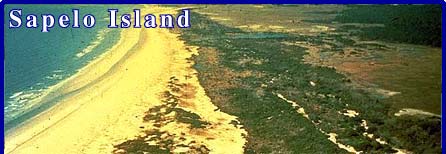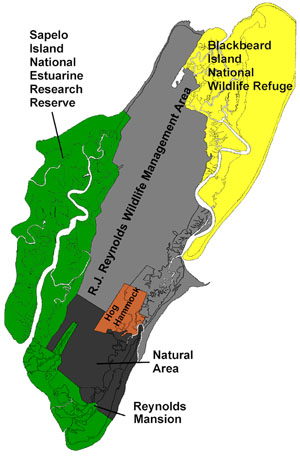
Altamaha Basin > Hydrology > Water Quality > Environmental Threats > Human Impacts > Cultural Features > Coastal Habitats > Tributaries > Plants > Animals > Sapelo Island |
||
 |
 |
||||||||
 |
|||||||||
|
Sapelo Island National Estuarine Research Reserve In 1975, the state of Georgia nominated the Duplin River Estuary as a national estuarine sanctuary, and in 1976 the state matched the federal funds provided by the National Oceanic and Atmospheric Administration (NOAA) and completed the purchase of the south end of Sapelo Island, establishing the Sapelo Island National Estuarine Research Reserve (SINERR). The Sapelo Island National Estuarine Research Reserve (SINERR) occupies 2390.74 ha, slightly more than one-third of the area of Sapelo Island. It contains the Duplin River watershed, primarily intertidal salt marsh with some small upland tracts, and the upland maritime forest, marsh, dune and beach areas of the southern end of the island, and a lighthouse built in 1820. The lighthouse has recently been restored to working condition using private funds. The University of Georgia leases approximately 637.65 ha within the SINERR on which are located the Marine Institute, residences of faculty and staff, administrative offices and other facilities related to the research and educational activities of the Marine Institute. SINERR is managed by the Georgia Department of Natural Resources (DNR), but is administered by the National Oceanic and Atmospheric Administration, which provides funds for operations, education and monitoring. The DNR’s management goals for the land in the SINERR include: a. maintaining the integrity of the SINERR for research and educational programs, b. protecting its lands and waters from stress and alteration, c. promoting increased public access for nature interpretation and low intensity recreation, and d. promoting and encouraging improved scientific understanding of estuarine ecosystems Public access to Sapelo Island is coordinated by SINERR personnel, who conduct tours which visit a tidal salt marsh and creek, the Marine Institute, ruins of a sugar mill built prior to the Civil war, the Hog Hammock Community, the Reynolds Mansion and Nannygoat Beach. In addition to public day tours, special group tours and tours for school field trips are available. In all 200-300 tours are conducted by SINERR staff each year. The Reserve personnel also conduct outreach programs, publish a newsletter about activities in the SINERR, and promote public awareness of the Reserve and the environmental and ecological aspects of Sapelo Island and the other Georgia barrier islands. |
 |
||||||||
| click on the image to see a larger version | |||||||||
|
More information on Sapelo Island History University of Georgia Marine Institute Sapelo Island National Estuarine Research Reserve Some Points of Interest on Sapelo Island |
|||||||||